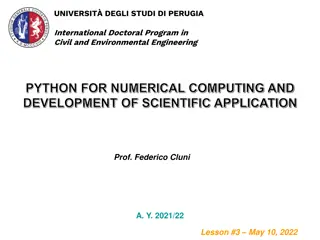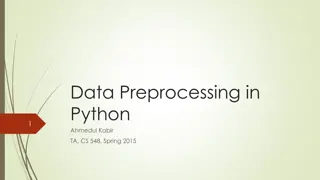Introduction to Numpy and Scipy: Numerical Computing in Python
Numpy and Scipy provide powerful MATLAB-like functionality in Python for fast numerical computations, high-level math functions, and efficient handling of multidimensional arrays. Learn why NumPy is essential for speeding up numerical computations in Python and explore key features such as arrays, mathematical operations, indexing, and broadcasting.
Download Presentation

Please find below an Image/Link to download the presentation.
The content on the website is provided AS IS for your information and personal use only. It may not be sold, licensed, or shared on other websites without obtaining consent from the author. Download presentation by click this link. If you encounter any issues during the download, it is possible that the publisher has removed the file from their server.
E N D
Presentation Transcript
Numpy and Scipy Numerical Computing in Python 1
What is Numpy? Numpy, Scipy, and Matplotlib provide MATLAB- like functionality in python. Numpy Features: Typed multidimentional arrays (matrices) Fast numerical computations (matrix math) High-level math functions 2
Why do we need NumPy Let s see for ourselves! 3
Why do we need NumPy Python does numerical computations slowly. 1000 x 1000 matrix multiply Python triple loop takes > 10 min. Numpy takes ~0.03 seconds 4
Logistics: Versioning In this class, your code will be tested with: Python 2.7.6 Numpy version: 1.8.2 Scipy version: 0.13.3 OpenCV version: 2.4.8 Two easy options: Class virtual machine (always test on the VM) Anaconda 2 (some assembly required) 5
NumPy Overview 1. Arrays 2. Shaping and transposition 3. Mathematical Operations 4. Indexing and slicing 5. Broadcasting 6
Arrays Structured lists of numbers. Vectors Matrices Images Tensors ConvNets 7
Arrays Structured lists of numbers. ?? ?? ?? Vectors Matrices Images ?11 ??1 ?1? ??? Tensors ConvNets 8
Arrays Structured lists of numbers. Vectors Matrices Images Tensors ConvNets 9
Arrays Structured lists of numbers. Vectors Matrices Images Tensors ConvNets 10
Arrays Structured lists of numbers. Vectors Matrices Images Tensors ConvNets 11
Arrays, Basic Properties import numpy as np a = np.array([[1,2,3],[4,5,6]],dtype=np.float32) print a.ndim, a.shape, a.dtype Arrays can have any number of dimensions, including zero (a scalar). 1. Arrays are typed: np.uint8, np.int64, np.float32, np.float64 2. Arrays are dense. Each element of the array exists and has the same type. 3. 12
Arrays, creation np.ones, np.zeros np.arange np.concatenate np.astype np.zeros_like, np.ones_like np.random.random 13
Arrays, creation np.ones, np.zeros np.arange np.concatenate np.astype np.zeros_like, np.ones_like np.random.random 14
Arrays, creation np.ones, np.zeros np.arange np.concatenate np.astype np.zeros_like, np.ones_like np.random.random 15
Arrays, creation np.ones, np.zeros np.arange np.concatenate np.astype np.zeros_like, np.ones_like np.random.random 16
Arrays, creation np.ones, np.zeros np.arange np.concatenate np.astype np.zeros_like, np.ones_like np.random.random 17
Arrays, creation np.ones, np.zeros np.arange np.concatenate np.astype np.zeros_like, np.ones_like np.random.random 18
Arrays, creation np.ones, np.zeros np.arange np.concatenate np.astype np.zeros_like, np.ones_like np.random.random 19
Arrays, creation np.ones, np.zeros np.arange np.concatenate np.astype np.zeros_like, np.ones_like np.random.random 20
Arrays, danger zone Must be dense, no holes. Must be one type Cannot combine arrays of different shape 21
Shaping a = np.array([1,2,3,4,5,6]) a = a.reshape(3,2) a = a.reshape(2,-1) a = a.ravel() 1. Total number of elements cannot change. 2. Use -1 to infer axis shape 3. Row-major by default (MATLAB is column-major) 22
Return values Numpy functions return either views or copies. Views share data with the original array, like references in Java/C++. Altering entries of a view, changes the same entries in the original. The numpy documentation says which functions return views or copies Np.copy, np.view make explicit copies and views. 23
Transposition a = np.arange(10).reshape(5,2) a = a.T a = a.transpose((1,0)) np.transpose permutes axes. a.T transposes the first two axes. 24
Saving and loading arrays np.savez( data.npz , a=a) data = np.load( data.npz ) a = data[ a ] 1. NPZ files can hold multiple arrays 2. np.savez_compressed similar. 25
Image arrays Images are 3D arrays: width, height, and channels Common image formats: height x width x RGB (band-interleaved) height x width (band-sequential) Gotchas: Channels may also be BGR (OpenCV does this) May be [width x height], not [height x width] 26
Saving and Loading Images SciPy:skimage.io.imread,skimage.io.imsave height x width x RGB PIL / Pillow: PIL.Image.open, Image.save OpenCV: cv2.imread, cv2.imwrite width x height x RGB height x width x BGR 27
Recap We just saw how to create arrays, reshape them, and permute axes Questions so far? 28
Recap We just saw how to create arrays, reshape them, and permute axes Questions so far? Now: let s do some math 29
Mathematical operators Arithmetic operations are element-wise Logical operator return a bool array In place operations modify the array 30
Mathematical operators Arithmetic operations are element-wise Logical operator return a bool array In place operations modify the array 31
Mathematical operators Arithmetic operations are element-wise Logical operator return a bool array In place operations modify the array 32
Mathematical operators Arithmetic operations are element-wise Logical operator return a bool array In place operations modify the array 33
Math, upcasting Just as in Python and Java, the result of a math operator is cast to the more general or precise datatype. uint64 + uint16 => uint64 float32 / int32 => float32 Warning: upcasting does not prevent overflow/underflow. You must manually cast first. Use case: images often stored as uint8. You should convert to float32 or float64 before doing math. 34
Math, universal functions Also called ufuncs Element-wise Examples: np.exp np.sqrt np.sin np.cos np.isnan 35
Math, universal functions Also called ufuncs Element-wise Examples: np.exp np.sqrt np.sin np.cos np.isnan 36
Math, universal functions Also called ufuncs Element-wise Examples: np.exp np.sqrt np.sin np.cos np.isnan 37
Indexing x[0,0] # top-left element x[0,-1] # first row, last column x[0,:] # first row (many entries) x[:,0] Notes: Zero-indexing Multi-dimensional indices are comma-separated (i.e., a tuple) # first column (many entries) 38
Indexing, slices and arrays I[1:-1,1:-1] # select all but one-pixel border I = I[:,:,::-1] # swap channel order I[I<10] = 0 # set dark pixels to black I[[1,3], :] # select 2nd and 4th row 1. Slices are views. Writing to a slice overwrites the original array. 2. Can also index by a list or boolean array. 39
Python Slicing Syntax: start:stop:step a = list(range(10)) a[:3] # indices 0, 1, 2 a[-3:] # indices 7, 8, 9 a[3:8:2] # indices 3, 5, 7 a[4:1:-1] # indices 4, 3, 2 (this one is tricky) 40
Axes a.sum() # sum all entries a.sum(axis=0) # sum over rows a.sum(axis=1) # sum over columns a.sum(axis=1, keepdims=True) 1. Use the axis parameter to control which axis NumPy operates on 2. Typically, the axis specified will disappear, keepdims keeps all dimensions 41
Broadcasting a = a + 1 # add one to every element When operating on multiple arrays, broadcasting rules are used. Each dimension must match, from right-to-left Dimensions of size 1 will broadcast (as if the value was repeated). Otherwise, the dimension must have the same shape. Extra dimensions of size 1 are added to the left as needed. 1. 2. 3. 42
Broadcasting example Suppose we want to add a color value to an image a.shape is 100, 200, 3 b.shape is 3 a + b will pad b with two extra dimensions so it has an effective shape of 1 x 1 x 3. So, the addition will broadcast over the first and second dimensions. 43
Broadcasting failures If a.shape is 100, 200, 3 but b.shape is 4 then a + b will fail. The trailing dimensions must have the same shape (or be 1) 44
Tips to avoid bugs 1. Know what your datatypes are. 2. Check whether you have a view or a copy. 3. Use matplotlib for sanity checks. 4. Use pdb to check each step of your computation. 5. Know np.dot vs np.mult. 45
Average images Who is this? 46
Practice exercise (not graded) Compute the average image of faces. 1. Download Labeled Faces in the Wild dataset (google: LFW face dataset). Pick a face with at least 100 images. 2. Call numpy.zeros to create a 250 x 250 x 3 float64 tensor to hold the result 3. Read each image with skimage.io.imread, convert to float and accumulate 4. Write the averaged result with skimage.io.imsave 47























